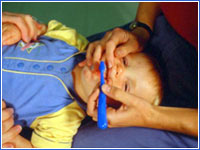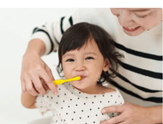Brushing and Flossing
Regular tooth brushing is important to remove plaque and food debris, and most importantly for distributing the fluoridated toothpaste.
Brushing Guidelines
- Brush twice daily beginning as soon as teeth emerge.
- Bedtime is most critical due to decreased salivary flow.
- Caregiver should brush child's teeth until age 8 or 9, at least until they have developed the manual dexterity to write in cursive or tie their own shoes because:
- Children will not reliably spit and may swallow toothpaste.
- Young children have difficulty adequately brushing all areas.
- Parents should continue to intermittently supervise brushing after children assume independence.
- Caregiver should stand or sit behind child.
- No food or drink after brushing.
- Floss once daily between teeth that touch. If teeth have space between them, good toothbrushing technique will clean the surfaces. If the teeth touch, the toothbrush cannot get between the surfaces and flossing once daily will aid in removal of food and plaque.


References
Chestnutt IG, Schafer F, Jacobson AP, Stephen KW. The influence of tooth brushing frequency and post-brushing rinsing on caries experience in a caries clinical trial. Community Dentistry & Oral Epidemiology. 1998;26(6):406-11.
Wright JT, Hanson N, Ristic H et al. Fluoride toothpaste efficacy and safety in children younger than 6 years: A systematic review. JADA. 2014. 145(2): 182-189.
Sotthipoka K, Thanomsuk P, Prasopsuk R, et al. The effects of toothpaste amounts and post-brushing rinsing methods on salivary fluoride retention", Journal of Health Research, 2018; 32(6): 421-431.
Duckworth R, M, Maguire A, Omid N, Steen I, N, McCracken G, I, Zohoori F, V: Effect of Rinsing with Mouthwashes after Brushing with a Fluoridated Toothpaste on Salivary Fluoride Concentration. Caries Res. 2009; 43:391-396.